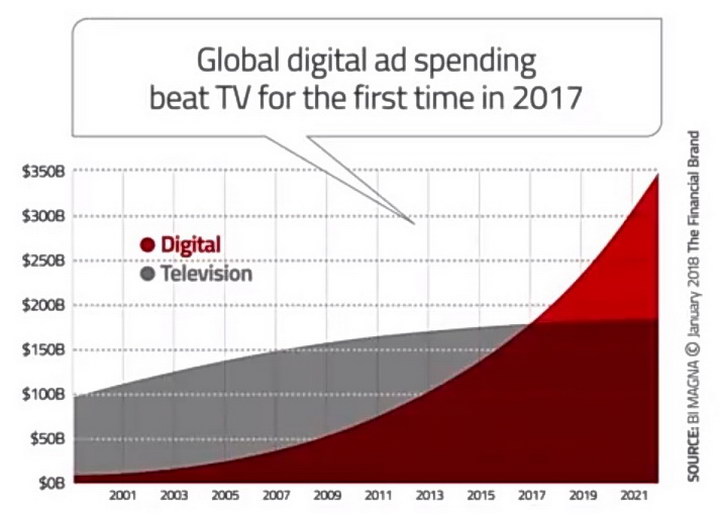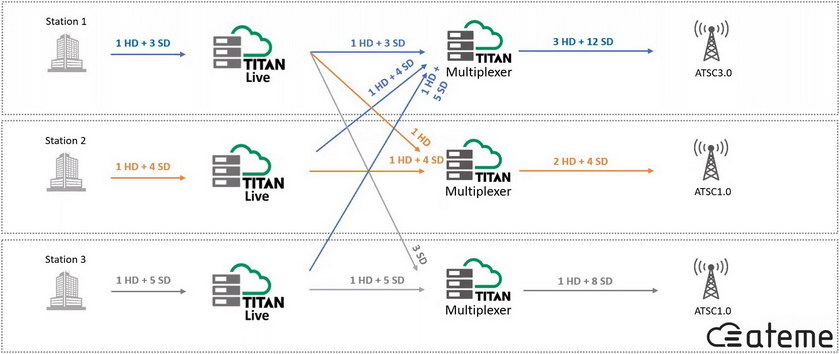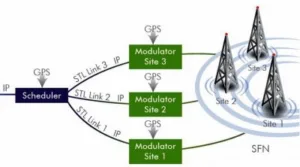My Display Daily for yesterday discussed ATSC 3.0 in general and what the lack of backward compatibility with ATSC 1.0 means to consumers. This lack of backward compatibility is actually a much more serious problem for broadcasters than consumers and this DD will look at what they are doing to solve those problems and bring ATSC 3.0 to US consumer markets.

Federal regulations and business requirements make the transition from ATSC 1.0 to ATSC 3.0 (AKA Next Gen TV) difficult for broadcasters. Unlike the NTSC to ATSC transition, broadcasters have not been given a second channel so they could simulcast their content in both formats while consumers got equipment able to receive the new format. But the FCC rule says that a broadcaster cannot stop broadcasting ATSC 1.0 in a market until they have been broadcasting ATSC 3.0 for at least five years.
 Television vs Digital (internet) Advertising Revenue (Credit BI Magna via Fayssal Kartobi at Enensys)
Television vs Digital (internet) Advertising Revenue (Credit BI Magna via Fayssal Kartobi at Enensys)
Why does the broadcasting industry want to make this rather difficult transition, considering it is not being mandated by the FCC? The figure showing TV vs Digital advertising revenue gives the fundamental reason: money. Advertising from ATSC 1.0 revenues are essentially static but revenues from digital advertising are growing rapidly. Today, “digital,” in practical terms, means the Internet. With the added capabilities of ATSC 3.0, the broadcasters expect to be able to grab a share of these digital advertising revenues by targeting ads more narrowly. With ATSC 1.0, an advertiser can target an ad at “Chicago” or wherever the transmitting tower is. With ATSC 3.0, they will be able to target the ad much more specifically, by localized area, by ethnic group, by socioeconomic group or by buying habits. Gaining access to these digital advertising revenues is the driving factor behind the development of ATSC 3.0 and the willingness of broadcasters to implement it, even in the face of serious technical and legal problems.
While ATSC 1.0 was based on advanced TV technology, ATSC 3.0 represents a radical change and is based on IP technology. Since it has been well demonstrated that IP technology can carry high quality, real-time video, this change will not affect TV broadcast image quality but will allow broadcasters to provide many additional capabilities with their broadcasts. Image quality may actually improve because ATSC 3.0 allows 4K broadcasts and can be extended in the future for 8K broadcasts.
With 8VSB and the MPEG-2 Codec, ATSC used most of its 6MHz bandwidth transmitting just a single HDTV signal, if it wanted to broadcast with image quality comparable to a DVD. The improved spectral usage of a 6MHz bandwidth by the orthogonal frequency-division multiplexing (OFDM) ATSC 3.0 uses allows ATSC 3.0 to broadcast up to 4.6x as many bits as ATSC 1.0 (up to 90Mbps vs. 19.4Mbps). In addition, ATSC 3.0 uses the HEVC Codec, so a HDTV image will only use about ¼ the bit rate used by MPEG-2 in ATSC 1.0. This leaves a huge bit rate capability above and beyond basic HDTV for the broadcaster to present ancillary material, including ads. Many of the new features are enabled or enhanced by a back channel from the consumer to the broadcaster over the Internet or by cellular service.
 Channel Sharing by multiple stations in a regional market (Credit: Ateme)
Channel Sharing by multiple stations in a regional market (Credit: Ateme)
So how do broadcasters get around the conundrum of not having an extra channel to broadcast on during the transition but the requirement that they simulcast ATSC 1.0 and 3.0 for five years during the transition? By channel sharing, as shown in the image. Take an example where there are three competing stations in a single regional market, all broadcasting with ATSC 1.0. Station 1 is broadcasting 1 HD and 3 SD channels, Station 2 is broadcasting 1 HD and 4 SD channels and Station 3 is broadcasting 1 HD and 5 SD channels. Under the FCC rules, all three stations must remain on the air and all the content for each of the stations must continue to be broadcast over ATSC 1.0. The FCC rules do not require the content to be broadcast on the same RF frequency (i.e. TV channel), however. In this example, Station 1 switches to ATSC 3.0 and, using its higher bit rate and better compression, broadcasts all 3 HD channels and all 12 SD channels. Station 2 takes on the 1 HD channel from Station 1 and broadcasts it, along with its own HD and 4 SD channels, over ATSC 1.0. Station 1’s 3 SD channels are sent off to Station 3 for broadcast along with Station 3’s HD channel and 5 SD channels via ATSC 1.0. This satisfies the FCC: all 3 HD and 12 SD channels remain on the air on both ATSC 3.0 and ATSC 1.0. After 5 years of this arrangement, Station 2 and Station 3 can stop broadcasting in ATSC 1.0, Switch to ATSC 3.0 and stop carrying Station 1’s content. Of course, Ateme hopes all three stations will use their Titan Live and Titan Multiplexer hardware, but that is not an FCC requirement.
One speaker said that the legal problems associated with switching from ATSC 1.0 to 3.0 can be as complex and as difficult as the technical problems. Another speaker said “It takes a village,” since multiple competing stations must cooperate to make a successful switch. Competing stations are willing to work together because they all want (and need) the additional revenue from digital advertising and other services enabled by ATSC 3.0.
 Content flow for an ATSC 3.0 Single Frequency Network (Credit: DekTek)
Content flow for an ATSC 3.0 Single Frequency Network (Credit: DekTek)
One capability of ATSC 3.0 that makes the business model work better but the technology more complex is the ability for a station to create a Single Frequency Network (SFN), as shown in the diagram. In a SFN, a single station can run multiple broadcast towers, all operating on the same RF channel assigned by the FCC. For an SFN to work, the RF signals at the three towers must be synchronized at the microsecond level. This is done with the Precision Time Protocol (PTP or IEEE 1588), which is why each tower has real-time input of GPS. GPS provides the precision timing data that drives the PTP. This SFN capability can be used by the station to enhance its signal in what would otherwise be a weak signal area. While the primary content on each of the three towers in the example is likely to be the same, the station can also use its SFN to target different portions of its broadcast area with different content and ads.
With both the consumer and broadcaster problems with ATSC 3.0 addressed and seem to be solvable, the future of ATSC 3.0 and the broadcasters are probably assured. Certainly, they are not “Doomed” at this point. However, ATSC 1.0 is likely to be with us for at least 10 more years, possibly longer. Don’t throw away your old TV, just to get the latest TV tuner. – Matthew Brennesholtz

